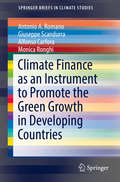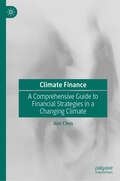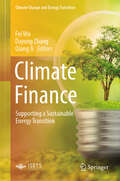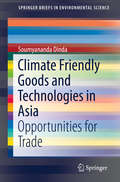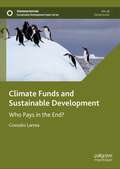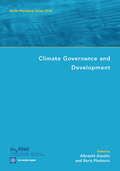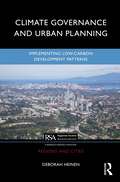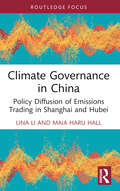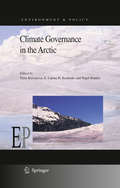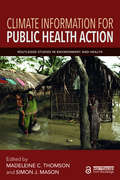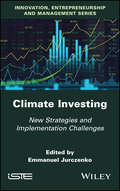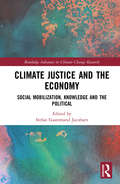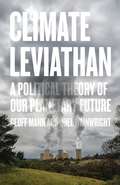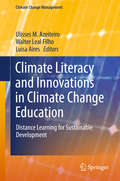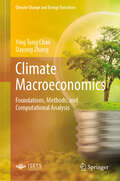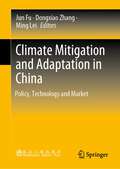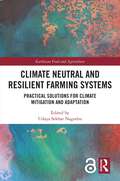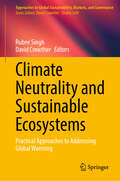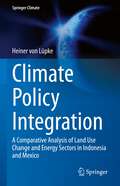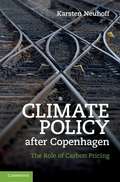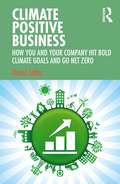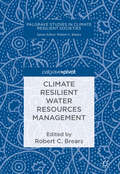- Table View
- List View
Climate Finance as an Instrument to Promote the Green Growth in Developing Countries (SpringerBriefs in Climate Studies)
by Antonio A. Romano Giuseppe Scandurra Alfonso Carfora Monica RonghiThis book analyses the effectiveness of climate finance as political instrument to reduce the effect of anthropogenic activities on climate change and promote the green growth in developing countries. The book highlights that close attention should also be paid to the analysis of political contexts in a broad sense. Particularly focusing on the international negotiations process that enables the direction of funds toward specific needs and priorities and the issue of access to electricity. For example, the difficulties that developing countries face when trying to improve their green economic development without access to carbon remains a matter of the utmost importance and urgency for many developing countries that lack significant aid from developed countries. This book will be of interest to a wide body of academics and practitioners in climate change and energy policies. Moreover, this project is a valid instrument for students in energy policies and climate programs.
Climate Finance: A Comprehensive Guide to Financial Strategies in a Changing Climate
by Jian ChenIn a world confronting the urgent realities of climate change, Jian Chen&’s Climate Finance offers an indispensable guide for professionals tackling our greatest global challenge. This comprehensive textbook seamlessly connects environmental science with financial innovation, empowering students, investors, business leaders, and policymakers to address the dual crises of climate risk and economic disruption. Through a structured five-part framework, Chen demystifies the complexities of mobilizing capital for climate solutions—from renewable energy investments and risk modeling to disclosure frameworks and portfolio management. With clear insights into physical and transition risks, cutting-edge financing mechanisms, and emerging trends, this book transforms climate challenges into actionable financial opportunities. Whether you&’re managing assets, shaping policy, or studying sustainability, Climate Finance equips you with the knowledge to drive meaningful change in the transition to a resilient, low-carbon economy. Take the first step toward building a sustainable future—your journey begins here.
Climate Finance: Supporting a Sustainable Energy Transition (Climate Change and Energy Transition)
by Fei Wu Qiang Ji Dayong ZhangThis book focuses on the frontier issues in climate finance and aims to develop a general framework to understand the financial pathways towards a successful energy transition. It builds upon the general descriptions of the current status and future challenges towards carbon neutral targets, and then bring forward a combination of theoretical and empirical analysis on the critical issues related to climate finance. Estimated by the International Energy Agency (IEA), trillions dollars of investment in energy sector are needed to achieve net-zero emission scenario. It provides a huge opportunity for our economies, meanwhile creates considerable challenges to the existing system. Both financing and investment in such an unprecedented scale cannot possibly be satisfied by the current financial architecture, which creates demands for restructuring in the financial sector, developing innovative financial instruments, building mechanisms to attract private investment, and establishing human resources to facilitate climate financing and investment. This area is essentially interdisciplinary, which requires a fundamental reconsideration of standard approaches. Aiming to satisfy the broad interests from both academia and policymakers, the contents of this book range from general discussions on critical issues to advanced statistical analyses on key topics. Authors hope to bring forward a general picture about climate finance and facilitate the demands for both academic research and policymaking. It should also provide a good guidance for graduate students interested in this subject. The main contents of this book are based on solid research outcomes but with clear policy relevance. The book combines finance theory and practices in both financial markets and energy sectors to reflect the complex nature of financing for energy transition. While the materials can provide useful knowledge to policymakers, the book can also inspire new research ideas in the relevant area.
Climate Friendly Goods and Technologies in Asia: Opportunities for Trade (SpringerBriefs in Environmental Science)
by Soumyananda Dinda<p>This book investigates the potential trade opportunity of climate friendly goods and technology (CFGT) in Asia and South Asia region, and uses a case study of India to clarify India's position on global warming and efforts to mitigate climate change impacts regionally and globally. In four main sections, the book applies econometric techniques to analyze the trade performance of CFGTs in nations in Asia and South Asia, in order to assess trade gaps and map the movement of CFGTs in these regions. The major themes addressed in the book include climate change and trade, issues that shape regional and national policies, and strategies for implementing global climate change mitigation on trade opportunities and developments. <p>Section 1 introduces readers to some background on global climate change threats and its effects on trade, as well as the need to develop trade for CFGTs. Section 2 assesses the trade performance of CFGTs in Asia, and South Asia, and the competitiveness of CFGT trade. Section 3 uses a regional orientation index to analyze CFGT trade. Section 4 discusses the potential business applications of CFGT trade in the Asia, South Asia region, and uses a case study on India to analyze climate change mitigation effects on trade and policy. The book will be of interest to researchers, students, governments, and policy makers.</p>
Climate Funds and Sustainable Development: Who Pays in the End? (Sustainable Development Goals Series)
by Gonzalo LarreaWhile significant attention has been devoted to achieving Sustainable Development Goal 13 (SDG 13) and scaling up climate finance for developing countries, the adverse impacts of funded projects on local communities remains inadequately explored by both academics and policymakers. Mobilizing climate finance on an unprecedented scale is undeniably vital for the success of developing countries’ climate policies. However, these initiatives often give rise to adverse consequences for individuals in these countries, leading to displacements, exacerbating food insecurity, or even triggering conflicts over resources.This book examines the extent to which the climate funds established for achieving SDG 13 are adequate for addressing climate change impacts in developing countries. Yet, its analysis transcends the mere evaluation of the sufficiency or efficacy of these efforts found in much of the existing literature. Beyond the scope of quantifiable success, the book delves into the root causes of the adverse impacts that these funds can have on local communities and offers tailored recommendations to realize the noble aspirations of SDG 13, all without implying that the individuals who should benefit from climate finance are the ones who pay in the end.
Climate Governance and Corporate Eco-innovation: A Framework for Sustainable Companies (Sustainable Finance)
by Vu Quang TrinhCorporations are increasingly dedicated to implementing more robust climate change practices in an era characterized by natural resource constraints, socio-environmental challenges, and mounting climate change pressures. This book provides a timely exploration of theoretical and empirical perspectives on global climate governance and corporate eco-innovation activities. It illustrates how corporations are actively addressing climate change by enhancing their climate governance systems and integrating eco-innovation into their operations, significantly impacting financial decision-making, policies, performance, risk management, and other crucial indicators. In this context, eco-innovation represents a corporation's ability to reduce environmental costs and burdens for its customers. It plays a vital role in helping firms improve energy and environmental efficiency, mitigate energy consumption, reduce carbon emissions, and minimize ecological harm during and after production. Additionally, eco-innovation can create new market opportunities by enhancing existing environmental technologies. Furthermore, the shift from conventional corporate governance to a heightened focus on corporate climate governance mechanisms, such as the establishment of ecological committees, the implementation of cli-mate incentives for managers and executives, and the publication of sustainability or climate change reports, proves to be an effective strategy for motivating firms to become more dedicated to environmental protection and eco-innovation initiatives.
Climate Governance and Development: Berlin Workshop Series 2010
by Boris Pleskovic Albrecht AnsohnThe Berlin Workshop Series 2010 presents selected papers from meetings held September 28-30, 2008, at the eleventh annual forum co-hosted by InWEnt and the World Bank in preparation for the Bank's annual World Development Report. At the 2008 meetings, key researchers and policy makers from Europe, the United States, and developing countries met to explore the problems that climate governance poses for development, which are later examined in depth in the 'World Development Report 2010'. This volume presents papers from the Berlin workshop sessions on climate governance and development, covering climate change as a development priority; policies and technologies for energy and development; natural resource governance for adaptation, mitigation, and development; non-state actors and climate governance; financing adaptation and mitigation in an unequal world; and changing institutions of governance for climate change. IN THIS VOLUME: Introduction by Aehyung Kim and Boris Pleskovic; opening remarks by Carola Donner-Reichle; keynote addresses by Rosina Bierbaum and Justin Yifu Lin; and papers by Richard J. T. Klein, Judith A. Layzer, Claudia Kemfert, Siri Eriksen, Kedziora and Zbigniew W. Kundzewicz, David Rogers, Charlotte Streck, John Scanlon and Clara Nobbe, and Hugh Compston and Ian Bailey.
Climate Governance and Urban Planning: Implementing Low-Carbon Development Patterns (Regions and Cities)
by Deborah HeinenUrban planning as a discipline is deeply integral to implementing a low-carbon future. This book fosters an understanding for how the rules-in-use that govern urban planning influence the ability to implement low-carbon development patterns. Drawing on the theoretical foundations of the climate governance and urban planning literatures, the book provides a context to understand plan implementation challenges and obstacles in metropolitan areas. As metropolitan regions across the globe seek to reduce emissions from transportation, many levels of governments have developed ambitious climate action plans that make land use and transportation recommendations in order to reduce vehicle miles traveled. Many have recommended low-carbon development patterns which are characterized by intensified and diversified uses around rapid transit stations. However, the implementation of these recommendations is done within the context of different "rules-in-use" unique to the planning systems in each metropolitan region. The book examines the rules-in-use in three metropolitan regions of similar demographic size: the Metro Vancouver, Puget Sound, and the Stuttgart regions. By examining the implementation of low-carbon development patterns, the book focuses on growth management related questions about how to coordinate transit investments with land use decisions in metropolitan regions. The book finds that state legislation that deals with metropolitan planning and regional growth strategies can greatly aid in creating accountability among actors as well as provide a road map to navigate conflicts when implementing low-carbon development patterns. By focusing on the rules-in-use, the book is of interest to policy-makers, planners, advocates, and researchers who wish to assess and improve the odds of implementing low-carbon development patterns in a metropolitan region.
Climate Governance in China: Policy Diffusion of Emissions Trading in Shanghai and Hubei (Routledge Focus on Environment and Sustainability)
by Lina Li Maia Haru HallThis book explores how and why innovative climate policies spread across subnational regions and between governance levels in China. Despite the significance of emerging economies in a pathway to a zero-carbon future, research to date on China’s transformation governance remains limited. Drawing on a theoretical framework for policy diffusion and based on extensive data from expert interviews with Chinese decisionmakers and policy practitioners, Lina Li and Maia Haru Hall focus on the policy of emissions trading systems (ETS) and two key case studies: Shanghai and Hubei. The authors examine the role of the national government and how much freedom the subnational regions have in developing ETS policy, as well as pinpointing key actors and the role of policy and knowledge diffusion mechanisms. Overall, this book sheds light on the competition between China and the West in the transition to climate-friendly societies and economies, highlighting opportunities for cooperation between them. This book will be of great interest to students and scholars of environmental politics and policy, climate change, urban studies, and Chinese studies more broadly.
Climate Governance in the Arctic (Environment & Policy #50)
by E. Carina Keskitalo Nigel Bankes Timo KoivurovaClimate change is affecting the Arctic environment and ecosystems at an accelerating speed, twice the rate of the global average. This is opening the Arctic to transportation and resource development and creating serious challenges for local communities and indigenous peoples. Climate Governance in the Arctic considers two aspects of climate change from an institutional perspective. It focuses on how relevant regimes, institutions and governance systems support mitigation of climate change. It also examines the extent to which the varying governance arrangements in the Arctic support adaptation and the development of adaptation processes for the region. The book's focus on Arctic governance offers unique insights within climate change mitigation and adaptation research.
Climate Information for Public Health Action (Routledge Studies in Environment and Health)
by Madeleine C. Thomson Simon J. MasonPolicy-makers are increasingly concerned about the impact of climate variability and change on the health of vulnerable populations. Variations and trends in climatic factors and extreme weather events impact many health outcomes, including malaria, heat stress and undernutrition. Climate Information for Public Health Action is based on the premise that climate knowledge and information can help protect the public from climate-sensitive health risks. With a focus on infectious disease, hydro-meteorological disasters and nutrition, the book explores why, when and how data on the historical, current and future (from days to decades) climate can be incorporated into health decision-making. Created as a collaborative effort between climate and health experts, this book targets a broad technical public health community, alongside development practitioners and policy-makers engaged in climate change adaptation. It may also guide climate experts in the development of climate services tailored to health needs. Written in an accessible, informative style, while maintaining the highest technical and scientific standards, it will also be a valuable resource for students and academics studying and working in the emerging field of environment and health. The Open Access version of this book, available at http://www.tandfebooks.com/doi/view/10.4324/9781315115603, has been made available under a Creative Commons Attribution-Non Commercial-No Derivatives 4.0 license."
Climate Investing: New Strategies and Implementation Challenges
by Emmanuel JurczenkoClimate Investing: New Strategies and Implementation Challenges
Climate Justice and the Economy: Social mobilization, knowledge and the political (Routledge Advances in Climate Change Research)
by Stefan Gaarsmand JacobsenAs climate change has increasingly become the main focus of environmentalist activism since the late 1990s, the global economic drivers of CO2 emissions are now a major concern for radical greens. In turn, the emphasis on connected crises in both natural and social systems has attracted more activists to the Climate Justice movement and created a common cause between activists from the Global South and North. In the absence of a pervasive narrative of transnational or socialist economic planning to prevent catastrophic climate change, these activists have been eager to engage with advanced knowledge and ideas on political and economic structures that diminish risks and allow for new climate agency. This book breaks new ground by investigating what kind of economy the Climate Justice movement is calling for us to build and how the struggle for economic change has unfolded so far. Examining ecological debt, just transition, indigenous ecologies, social ecology, community economies and divestment among other topics, the authors provide a critical assessment and a common ground for future debate on economic innovation via social mobilization. Taking a transdisciplinary approach that synthesizes political economy, history, theory and ethnography, this volume will be of great interest to students and scholars of climate justice, environmental politics and policy, environmental economics and sustainable development.
Climate Leviathan: A Political Theory of Our Planetary Future
by Joel Wainwright Geoff MannHow climate change will affect our political theory—for better and worseDespite the science and the summits, leading capitalist states have not achieved anything close to an adequate level of carbon mitigation. There is now simply no way to prevent the planet breaching the threshold of two degrees Celsius set by the Intergovernmental Panel on Climate Change. What are the likely political and economic outcomes of this? Where is the overheating world heading?To further the struggle for climate justice, we need to have some idea how the existing global order is likely to adjust to a rapidly changing environment. Climate Leviathan provides a radical way of thinking about the intensifying challenges to the global order. Drawing on a wide range of political thought, Joel Wainwright and Geoff Mann argue that rapid climate change will transform the world’s political economy and the fundamental political arrangements most people take for granted. The result will be a capitalist planetary sovereignty, a terrifying eventuality that makes the construction of viable, radical alternatives truly imperative.
Climate Liberalism: Perspectives on Liberty, Property and Pollution (Palgrave Studies in Classical Liberalism)
by Jonathan H. AdlerClimate Liberalism examines the potential and limitations of classical-liberal approaches to pollution control and climate change. Some successful environmental strategies, such as the use of catch-shares for fisheries, instream water rights, and tradable emission permits, draw heavily upon the classical liberal intellectual tradition and its emphasis on property rights and competitive markets. This intellectual tradition has been less helpful, to date, in the development or design of climate change policies. Climate Liberalism aims to help fill the gap in the academic literature examining the extent to which classical-liberal principles, including an emphasis on property rights, decentralized authority and dynamic markets, can inform the debate over climate-change policies. The contributors in this book approach the topic from a range of perspectives and represent multiple academic disciplines. Chapters consider the role of property rights and common-law legal systems in controlling pollution, the extent to which competitive markets backed by legal rules encourage risk minimization and adaptation, and how to identify the sorts of policy interventions that may help address climate change in ways that are consistent with liberal values.
Climate Literacy and Innovations in Climate Change Education: Distance Learning for Sustainable Development (Climate Change Management)
by Walter Leal Filho Ulisses M. Azeiteiro Luísa AiresThis book addresses the links between climate change and the threats it poses to sustainable development, from a distance education perspective. Discussing current trends and challenges in sustainable development education, climate literacy and innovations in climate change education, it contributes to the global debate on the implementation of education for sustainability. It also assesses the role that e-learning can play in this process, addressing pedagogical concepts as well as the wide range of technological options now available.
Climate Macroeconomics: Foundations, Methods, and Computational Analysis (Climate Change and Energy Transition)
by Dayong Zhang Ying Tung ChanThis book provides a unique bridge between theoretical foundations and practical implementation of environmental economics modeling. Through a progressive approach, it guides readers from basic analytical frameworks to advanced computational techniques for analyzing climate change policies. Starting with intuitive partial equilibrium models, the book systematically builds understanding of three major modeling frameworks: Environmental Dynamic Stochastic General Equilibrium (E-DSGE), Dynamic Integrated Climate-Economy (DICE), and Computable General Equilibrium (CGE) models. Each framework is thoroughly explained with detailed MATLAB implementations, making complex concepts accessible and practical. The book's distinctive two-part structure serves multiple audiences: Part I develops fundamental concepts through analytically solvable models ideal for advanced undergraduates, while Part II explores sophisticated modeling approaches suitable for graduate students and researchers. Throughout, readers benefit from: Comprehensive coverage of carbon taxation, cap-and-trade systems, and other environmental policy instruments Detailed MATLAB code for implementing theoretical concepts Clear connections between different modeling approaches for policy analysis Whether you're an economics student learning environmental modeling, a policy analyst working on climate regulations, or a researcher comparing modeling frameworks, this book provides the tools to engage with modern environmental economic analysis.
Climate Mitigation and Adaptation in China: Policy, Technology and Market
by Jun Fu Dongxiao Zhang Ming LeiClimate change is a huge challenge to humanity in the 21th century. In view of China’s recent pledge to the international community to peak carbon emissions before 2030 and achieve carbon neutrality by 2060, this book examines climate mitigation and adaptation efforts in China through the prism of the steel sector, and it does so from three interrelated perspectives, i.e., policy, technology, and market. The book argues that in developing the country’s strategy towards green growth, over the years there has been a positive and interactive relationship between China’s international commitments and domestic agenda setting in mitigation and adaptation to the impact of climate change. To illustrate China’s efforts, two special areas, i.e., carbon capture, utilization and storage (CCUS) and emissions-trading system (ETS), have received focused examination. Along the spectrum of low-carbon, zero-carbon, and negative-carbon strategies, this study ends with a simulation model which outlines different policy scenarios, challenges, and uncertainties, as China moves further on, trying to achieve carbon neutrality in 2060. The book will be of interest to scholars, policy-makers, and business executives who want to understand China’s growing role in the world.
Climate Neutral and Resilient Farming Systems: Practical Solutions for Climate Mitigation and Adaptation (Earthscan Food and Agriculture)
by Udaya Sekhar NagothuThis book presents evidence-based research on climate-neutral and resilient farming systems and further to provide innovative and practical solutions for reducing greenhouse gas emissions and mitigating the impact of climate change. Intensive farming systems are a significant source of greenhouse gas emissions, thereby contributing to global warming and the acceleration of climate change. As paddy rice farming is one of the largest contributors, and most environmentally damaging farming systems, this will be a particular focus of the book. The mitigation of greenhouse gas emissions needs to be urgently addressed to achieve the 2 degrees Celsius target adopted by COP21 and the 2015 Paris Agreement, but this is not possible if local and national level innovations are not accompanied by international level cooperation, mutual learning and sharing of knowledge and technologies. This book, therefore, brings together international collaborative research on climate-neutral and resilient farming systems compiled by leading scientists and experts from Europe, Asia and Africa. The chapters present evidence-based research and innovative solutions that can be applied or upscaled in different farming systems and regions across the world. Chapters present models and technologies that can be used for practical implementation at the systemic level and advance state of the art knowledge on carbon neutral farming. Combining theory and practice, this interdisciplinary book provides guidance which can inform and increase cooperation between researchers from various countries on climate-neutral and resilient farming systems. Most importantly, the volume provides recommendations which can be put into practice by those working in the agricultural industry, especially in developing countries, where they are attempting to promote climate-neutral and resilient farming systems. The book will be of great interest to students and academics of sustainable agriculture, food security, climate mitigation and sustainable development, in addition to policymakers and practitioners working in these areas.
Climate Neutrality and Sustainable Ecosystems: Practical Approaches to Addressing Global Warming (Approaches to Global Sustainability, Markets, and Governance)
by David Crowther Rubee SinghThis book is an essential contribution to the growing discourse on climate change, sustainability, and global warming. It explores the complex challenges of climate change and provides actionable strategies for achieving climate neutrality, emphasizing the balance between economic growth and ecosystem preservation. Highlighting the critical role of government leadership and policy integration, the book explores how collaboration across stakeholders, i.e., governments, private sectors, civil society, and international organizations, can drive sustainable frameworks. It provides examples of forward-thinking policies and initiatives that have successfully reduced carbon emissions and promoted green technologies worldwide. A significant focus is placed on the interconnectedness of human activity and ecosystems, addressing the delicate balance of ocean health, migration patterns, and economic systems. The book also explores the unique challenges faced by developing nations, emphasizing the need for adaptive strategies to ensure food security, growth, and resilience to extreme weather events. With sector-specific insights, the book highlights how industries like energy, transport, and tourism can adopt sustainable practices, leveraging technology and human capital to transition to a low-carbon future. Additionally, it examines the role of climate finance in supporting this transition, showcasing tools like green bonds, carbon pricing, and international funds. Featuring real-world examples and case studies, the book offers a practical guide for policymakers, businesses, and practitioners, providing a roadmap for scalable and innovative climate solutions. It is a must-read for anyone dedicated to fostering a sustainable and climate-resilient future.
Climate Policy Integration: A Comparative Analysis of Land Use Change and Energy Sectors in Indonesia and Mexico (Springer Climate)
by Heiner von LüpkeThis book analyzes climate policy integration processes by investigating cause-effect relations in cases of integrating climate policy in energy and land-use sectors of Indonesia and Mexico, taking a novel comparative case study approach. The book identifies root causes for integration outside of the public administration, discussing decisive factors in the political economy of the energy and land-use sectors. Showing how policy windows may open for the successful integration of climate policies nevertheless, the book addresses the need to identify and properly use these windows to establish the administrative and institutional arrangements for effective climate policy implementation. This book offers two-fold insights for overcoming the challenges posed by climate policy integration: Firstly, it contributes to theory-building by amending theories of the policy process and by taking a wider perspective on the role of integration in the context of transformational change processes in emerging economies. Secondly, it sets forth a set of research-based practical policy recommendations on how to foster climate policy integration in the political decision-making processes as well as the public administration structures. Therefore, this book will appeal to scholars and researchers of public policy, public administration, political science, and environmental sciences, as well as policy-makers and practitioners interested in a better understanding of climate policy integration in energy and land-use sectors.
Climate Policy after Copenhagen
by Karsten NeuhoffAt the UN Climate Negotiations in Copenhagen, 117 heads of state concluded that low-carbon development is necessary in order to combat climate change. However, they also understood that transition to a low-carbon economy requires the implementation of a portfolio of policies and programs - a challenging endeavour for any nation. This book addresses the need for information about factors impacting climate policy implementation, using as a case study one effort that is at the heart of attempts to create a low-carbon future: the European Emission Trading Scheme. It explores problems surrounding the implementation of the ETS, including the role of vested interests, the impact of design details and opportunities to attract long-term investments. It also shows how international climate cooperation can be designed to support the domestic implementation of low-carbon policies. This timely analysis of carbon pricing contains important lessons for all those concerned with the development of post-Copenhagen climate policy.
Climate Positive Business: How You and Your Company Hit Bold Climate Goals and Go Net Zero
by David JaberThis is the decade for climate action. Internal and external stakeholders demand action. How we choose to act in the next ten years will determine our foreseeable future. Businesses hold a critical role for climate futures. The need for businesses to reduce their carbon footprint is now unquestioned, but how to achieve reductions in a credible way is neither clear nor easy once you’ve tackled the obvious energy culprits. Climate Positive Business lays out the path of business climate strategy, highlighting how your business must set goals, measure impact, and improve performance. Greenhouse gas protocols can instruct you on the core accounting process that lies at the heart of climate strategy. At least as important to success are the details that protocols don’t tell you: the sticking points; the areas of controversy, and the best practices. Rooted in real experience and written in an entertaining and engaging style, this book provides you with the tips, tools, and techniques to tackle your company’s carbon footprint, and it helps you do so in a way that is credible and appropriately ambitious to meet stakeholder expectations. The book will equip you with tools to think critically about GHG reduction, carbon offsets, and carbon removal, as well as help ensure we collectively implement real solutions to slow and eventually reverse the climate crisis. It includes lessons learned from real-world consulting projects and provides a plan of action for readers to implement. A go-to book for business looking to understand, manage, and reduce their carbon footprint, it is an invaluable resource for sustainable business practitioners, consultants, and those aspiring to become climate champions.
Climate Protection and Environmental Interests in Renewable Energy Law: Perspectives from Brazil and Germany
by Paula Galbiatti SilveiraThis book is about environmental and climate legal protection in the energy transition. The Paris Agreement has a binding commitment of holding the global temperature increase to 2°C while pursuing efforts to limit it to 1.5°C. To cope with the negative effects of climate changes and mitigate greenhouse gas emissions, one of the primary responses has been the deployment of renewable energy sources, transiting from fossil fuels to sustainable electricity production. However, renewable energy sources can also cause significant environmental impacts. Wind energy, for instance, can impact biodiversity, such as birds and bats, killing them when colliding with turbines and affecting their migration and nesting.This results in conflicts in environmental law. This book questions whether, in the energy transition, the generation of electricity from renewable sources to protect the climate is compatible with the protection of the environment, both interests in environmental law.To address this question, this book follows a legal-environmental perspective and assesses the common problem of solving those internal environmental conflicts in Brazilian and German law to understand and compare whether and how both legal systems solve the conflicts by compatibilizing the protection of the climate with other environmental interests. The legal analysis focuses on land-use planning and environmental licensing, assessing similarities and differences, and evaluating the results, identifying what one country can learn from the other.
Climate Resilient Water Resources Management (Palgrave Studies In Climate Resilient Societies Ser.)
by Robert C. BrearsThe effects of climate change are beginning to impact water quantity and water quality across the globe. However, there is no single action or strategy that any government can implement to ensure a community is resilient to climate change-related extreme weather events while also protecting the natural system. Instead, Robert Brears argues, climate resilient water resources management requires integrated, forward-thinking policies that are not only adaptable to changing climatic conditions but also seek to maximise economic and social welfare in an equitable manner while ensuring the continued health of their ecosystems. This book addresses how several levels of government in different geographical locations, with varying climates, incomes, and lifestyles, have implemented a variety of policies and technologies to ensure communities are resilient to climatic risks, and how these policies preserve and enhance the natural system and its associated ecosystem’s health.
